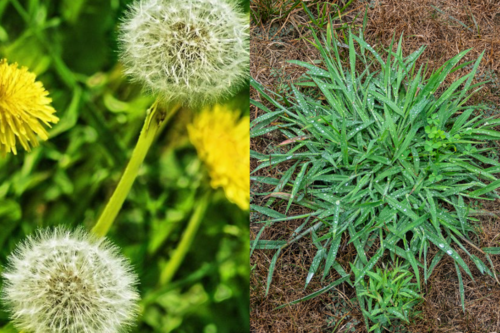The Difference Between Broadleaf Weeds and Crabgrass

Do you know the difference between broadleaf weeds and crabgrass?
Do you know why it’s important to treat your lawn for both?
Understanding the difference between broadleaf weed control and crabgrass control, as well as why they’re both important, is essential for effective lawn management and growing healthy, vibrant grass.
Broadleaf Weed Control
Broadleaf weeds are common in lawns and gardens, characterized by their broad, flat leaves and rapid growth. Examples of broadleaf weeds include dandelions, clover, and chickweed. These weeds can compete with grass for water, nutrients, and sunlight, leading to a thinning lawn if left uncontrolled.
Broadleaf weed control involves the use of herbicides specifically formulated to target and eliminate these types of weeds while sparing desirable grass species. These herbicides work by disrupting the growth and development of broadleaf weeds, eventually causing them to wither and die.
Crabgrass Control
Crabgrass is a type of annual grass weed that poses a unique challenge for lawn owners. Unlike broadleaf weeds, crabgrass is a grass species characterized by its low-to-the-ground, quick-spreading growth pattern. It thrives in warm weather and can quickly take over lawns, forming dense patches that smother desirable grasses.
Crabgrass control primarily involves prevention and suppression, as eliminating established crabgrass plants can be challenging once they've taken hold. Pre-emergent herbicides are commonly used to prevent crabgrass seeds from taking root, forming a barrier in the soil that inhibits their growth. Post-emergent herbicides may also be used to target existing crabgrass plants, although they are less effective once the weeds have matured.
Regular lawn maintenance practices, such as proper mowing, watering, and fertilization, can also help discourage crabgrass growth by promoting the health and vigor of your lawn's existing grass. Additionally, overseeding with desirable grass varieties can help fill in thin areas and keep crabgrass from taking space and resources.
The Importance of Treating Both
Both broadleaf weed control and crabgrass control are essential components of effective lawn maintenance for several reasons:
Aesthetic Appeal: Weeds detract from the curb appeal of your lawn. Controlling both broadleaf weeds and crabgrass helps maintain lush, green grass that enhances the beauty of your home.
Health of the Lawn: Weeds compete with desirable grass species for resources like water, nutrients, and sunlight. By controlling weeds, you allow your lawn to thrive, resulting in healthier and more resilient turf.
Prevention of Spread: Left unchecked, weeds can quickly spread and establish dense patches, making them more challenging to control in the long run. Early intervention can prevent weed infestations from spreading and becoming more difficult to manage.
Optimal Growing Conditions: Controlling weeds creates optimal growing conditions for your lawn, allowing grass to establish a dense, healthy turf that is better able to resist weeds and other stressors.
Beat the Weeds with Professional Lawn Care in Livingston County
Don’t take on the challenge of broadleaf weeds and crabgrass alone! Let a professional lawn care company in Livingston County take the burden off your shoulders. To set your lawn up for success this summer, call (517) 540-1100 or request a quote here.




